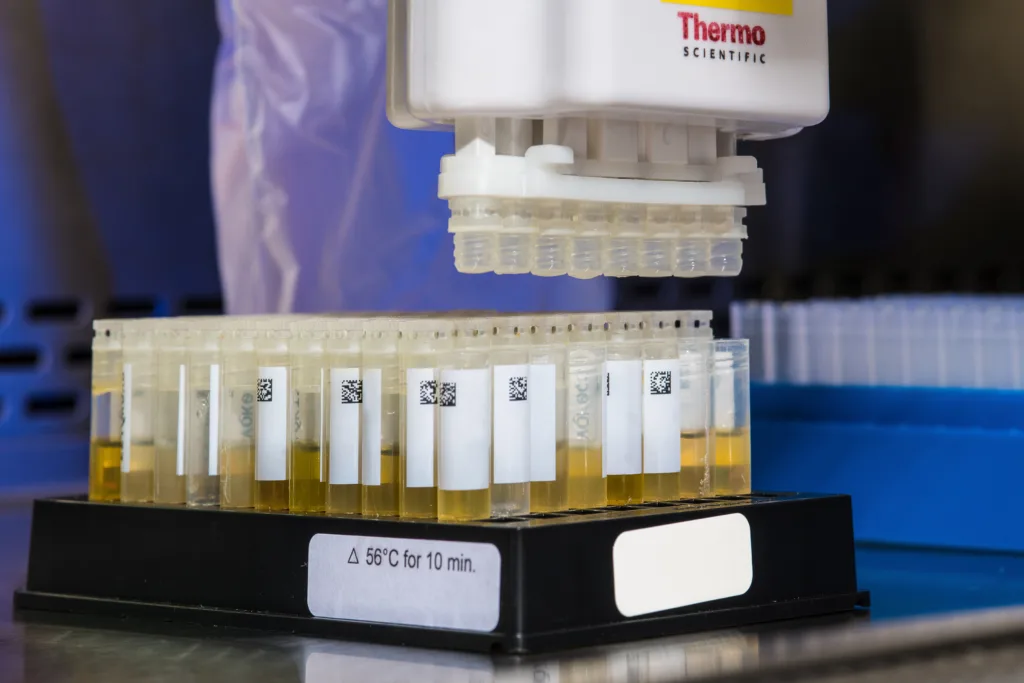Mixed urogenital flora is a term used by clinical laboratories to descibe the presence of multiple types of bacteria in a urine sample, with no single type predominating. This can occur due to contamination of the sample from the skin or genital area, or due to the natural bacterial flora present in the urogenital tract.
In females, the type of bacterial flora present in the vagina can vary depending on factors such as age, pH, and hormonal levels. In female infants, Lactobacillus spp. are the predominant bacteria present, with a vaginal pH of approximately 5.
However, in some cases, the presence of mixed urogenital flora can be indicative of a urinary tract infection (UTI), particularly if symptoms such as pain or burning during urination, frequent urination, or urgency are present. In these cases, further testing and treatment may be necessary to address the underlying infection.
It is important to note that the presence of epithelial cells on microscopy can also indicate contamination of the urine sample, further highlighting the importance of collecting urine samples in a sterile manner.
The presence of mixed urogenital flora in a urine sample should be interpreted in the context of the patient’s symptoms and clinical history, and further testing may be necessary to determine the underlying cause.
What Is Mixed Urogenital Flora?
Mixed urogenital flora is a term used to describe the presence of multiple types of bacteria in the urogenital tract, including the urinary and genital systems. When a sample of urine or genital secretions is collected and cultured, if thre are three or more different types of bacteria present and none of them are present in high enough numbers to be considered the dominant species, the results may be reported as mixed urogenital flora. This can occur in both men and women and is not necessarily an indication of a specific infection or disease. However, if symptoms of a urogenital infection are present, further testing and treatment may be necessary.

What Does It Mean When A Urine Culture Showed Mixed Flora?
When a urine culture shows ‘mixed flora’, it means that the urine sample contains a variety of different bacterial species that may be originating from the skin or genital area, and not necessarily from the urinary tract. This can happen if the urine sample is not collected in a sterile manner. The presence of mixed flora can make it difficult to identify the specific bacteria causing an infection, as well as to determine the appropiate treatment. The clinical laboratory may report the presence of mixed flora as ‘mixed growth bacteria’. It is important to collect urine samples in a sterile manner to ensure accurate diagnosis and effective treatment of urinary tract infections.
What Is Urogenital Flora Mean?
Urogenital flora refers to the microorganisms that naturally reside in the urogenital tract of humans, which includes the genital organs and urinary system. These microorganisms can include both beneficial and harmful bacteria, depending on the individual’s age, hormonal levels, and overall health. The type of bacterial flora found in the urogenital tract can vary greatly, with Lactobacillus spp. being the predominant species in female infants with a vaginal pH of approximately 5 during their first month of life. Understanding the composition and balance of urogenital flora is important in maintaining urogenital health and preventing infections.
Is Mixed Growth In Urine An Infection?
Mixed growth in urine is not necessarily an infection. It can indicate contamination with bacteria from the skin, vagina or bowel. These bacteria can be harmless or pathogenic, meaning they can cause disease. Therefore, a urine culture report that shows mixed growth requires futher evaluation by a healthcare provider to determine if the bacteria present are causing an infection or not. It is important to note that the presence of epithelial cells on microscopy also indicates contamination, and should be taken into consideration when interpreting the results. mixed growth in urine culture does not always indicate an infection, but it requires careful assessment by a healthcare provider.

Conclusion
Mixed urogenital flora is a term used to describe the presence of multiple types of bacteria in the urinary tract or vagina. While this can be indicative of a bacterial infection in some cases, it may also be the result of contamination from the skin or genital area during urine collection or testing. The type of bacterial flora found in the vagina varies depending on the age, pH, and hormonal levels of the host. Lactobacillus spp. are typically the predominant bacteria in female infants during the first month of life. It is important to note that the presence of mixed growth bacteria or epithelial cells on urine culture reports may indicate contamination and not necessarily a true infection. Therefore, careful interpretation of these results is necessary to ensure appropiate diagnosis and treatment.
